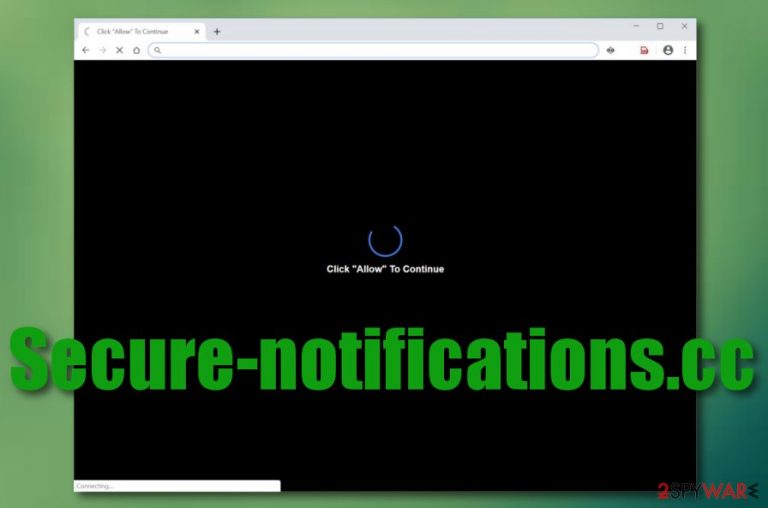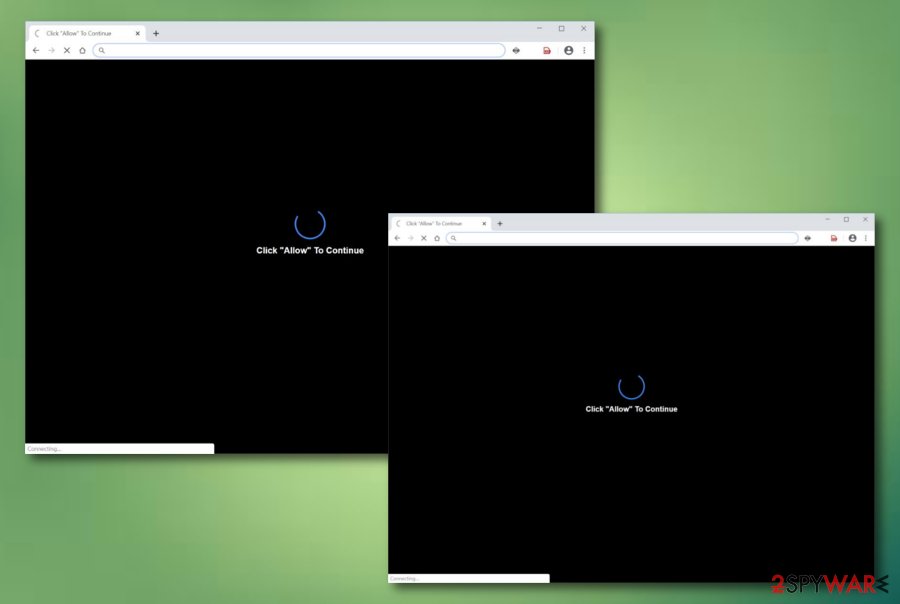Secure-notifications.cc (Free Guide) - Virus Removal Instructions
Secure-notifications.cc Removal Guide
What is Secure-notifications.cc?
Secure-notifications.cc is adware that supports intrusive activities such as advertising and redirecting during online sessions

Secure-notifications.cc is an adware[1] app that can take the user to multiple rogue domains and flood the computer screen with questionable offers. This potentially unwanted program has been targetting browsers of all kinds and interacting with their major settings such as the homepage and new tab URL bar. The infection process begins by installing a rogue process into the Task Manager and injecting extensions[2] into browser apps. Afterward, Secure-notifications.cc virus starts delivering an excessive amount of advertisements that support various rogue deals and offers. However, there are also other activities that the user has to deal with during the adware attack, e.g. redirecting to affiliate sources, collecting browsing-based data.
| Name | Secure-notifications.cc |
|---|---|
| Type | Adware/potentially unwanted program |
| Danger | This adware is not categorized as malware so it holds the danger level of low. However, some indirect damage can be caused through redirecting sessions that might take the user to malware-laden domains |
| Activities | The adware program can get the user involved in intrusive advertising activities, redirecting during browser sessions, changing the browser's homepage and new tab URL, and collecting non-personal information that is related to the browsing experience and habits of the user |
| Removal | You can eliminate the adware program with the help of automatical software or the manual step-by-step guidelines that have been added to the end of this article |
| Fix tip | If your computer system has experienced some type of compromisation, you can try repairing the machine with a tool such as FortectIntego |
Secure-notifications.cc can also deliver a show notifications message that urges to click the “Allow” button. We recommend opting for the “Block” option or just closing the entire window. If you agree with the incoming notification flow, you will likely find yourself flooded with numerous useless advertisements.
Secure-notifications.cc pop-up ads are likely to deliver various offers and deals that seak to swindle money from the users. For example, adware programs might promote rogue security software and encourage users to pay for useless tools. Additionally, they might provide some scams about system infections to make the risks look more real.
Continuously, Secure-notifications.cc can get the user involved in various surveys. If the PUP asks you to provide any personal information or credentials, do not fill in the blanks. There might be various hackers lurking in the cyberspace and waiting for a user to expose its private data so it could be misused for illegitimate purposes.
Furthermore, the ads that start coming from Secure-notifications.cc can increase more in time. You might not be able to perform browsing sessions properly do to the big number of notifications showing up. Also, the intense activity might start using up your system resources that can sometimes result in an overheated CPU.
The appearance of Secure-notifications.cc shows that the person's computer is lacking protection somewhere, otherwise, such product would not have approached. The potentially unwanted program can come not alone. Adware apps are often distributed with other suspicious products such as additional adware, browser hijackers, scareware, etc.

Another annoying and even potentially dangerous feature of Secure-notifications.cc is redirecting. Most of the time, you will be taken to sponsored domains that are filled with attractive-looking deals and aim to gain revenue. However, in other cases, there is a possibility of landing on a source that is infected with malware.
However, this is still not all about Secure-notifications.cc activities. The adware might also aim to record your browsing details related to your habits experience and history. Developers gather this type of non-personal information so that they could pass it on to other parties for income or use it in targeted advertising campaigns.
The only way to stop these tasks is to remove Secure-notifications.cc from your infected web browsers and computer system. You can complete this type of process by using the manual step-by-step guidelines that have been added to the end of this article or by employing automatical software.
Note that the Secure-notifications.cc removal needs to be carried out on browsers too. These apps can also hold adware-related content. After every directory is cleaned, you can search for possible system compromisation that might have occurred during the adware attack. If some damage is found, you can try repairing things with FortectIntego.
In some cases, you can meet Secure-notifications.cc while visiting third-party sources. If this domain does not load you with adverts intensively, there might be no adware in your computer system. For this purpose, perform a full machine scan and if nothing is found, install Adblock Plus or AdBlock to prevent the rare occasions of advertising.

The most popular distribution techniques of adware apps
Security specialists from LosVirus.es[3] state that adware apps are intensively spread through a deceptive marketing technique known as “bundling”. The developers add their products into bundles[4] of regular software that get downloaded by careless users from sources such as download.com, cnet.com, softonic.com, etc.
Continuously, those who have set “Recommended” as their default downloading mode, have an increased chance of receiving adware on their computer systems. Instead of leaving your device vulnerable, you should opt for the “Advanced” settings where you will be the one responsible for all incoming products.
In addition, adware apps can get distributed through infectious adverts and hyperlinks that the users meet while browsing online. Some pop-ups might be disguised as fake flash player updates and encourage to download them. Do not download any updates without checking them on the official websites first.
These are the manual steps that you can take. However, there also is an automatical part of the prevention tactics. You should not be afraid to invest in automatical security software as these programs are able to protect the user from various incoming threats, alert when something wrong is happening, and clean the entire computer system.
Manual and automatical removal guidelines for Secure-notifications.cc
You can successfully remove Secure-notifications.cc by performing the manual step-by-step guidelines that have been included at the end of this article or by using automatical software. If you want to go for the manual option, you should overthink everything twice, i.e. are the skills that you have enough, are you ready to spend some time on the task, etc.
If you think that you are just incapable of performing the Secure-notifications.cc removal on your own or you are short in time, then you should definitely opt for antimalware software. Choose a reliable program, download it to the computer system, launch it, and wait for the process to be finished in a few minutes.
You may remove virus damage with a help of FortectIntego. SpyHunter 5Combo Cleaner and Malwarebytes are recommended to detect potentially unwanted programs and viruses with all their files and registry entries that are related to them.
Getting rid of Secure-notifications.cc. Follow these steps
Uninstall from Windows
To remove potentially unwanted programs from Windows, use these instructing steps.
Instructions for Windows 10/8 machines:
- Enter Control Panel into Windows search box and hit Enter or click on the search result.
- Under Programs, select Uninstall a program.

- From the list, find the entry of the suspicious program.
- Right-click on the application and select Uninstall.
- If User Account Control shows up, click Yes.
- Wait till uninstallation process is complete and click OK.

If you are Windows 7/XP user, proceed with the following instructions:
- Click on Windows Start > Control Panel located on the right pane (if you are Windows XP user, click on Add/Remove Programs).
- In Control Panel, select Programs > Uninstall a program.

- Pick the unwanted application by clicking on it once.
- At the top, click Uninstall/Change.
- In the confirmation prompt, pick Yes.
- Click OK once the removal process is finished.
Delete from macOS
To clean your macOS computer system from bogus content, apply these instructions.
Remove items from Applications folder:
- From the menu bar, select Go > Applications.
- In the Applications folder, look for all related entries.
- Click on the app and drag it to Trash (or right-click and pick Move to Trash)

To fully remove an unwanted app, you need to access Application Support, LaunchAgents, and LaunchDaemons folders and delete relevant files:
- Select Go > Go to Folder.
- Enter /Library/Application Support and click Go or press Enter.
- In the Application Support folder, look for any dubious entries and then delete them.
- Now enter /Library/LaunchAgents and /Library/LaunchDaemons folders the same way and terminate all the related .plist files.

Remove from Microsoft Edge
Delete unwanted extensions from MS Edge:
- Select Menu (three horizontal dots at the top-right of the browser window) and pick Extensions.
- From the list, pick the extension and click on the Gear icon.
- Click on Uninstall at the bottom.

Clear cookies and other browser data:
- Click on the Menu (three horizontal dots at the top-right of the browser window) and select Privacy & security.
- Under Clear browsing data, pick Choose what to clear.
- Select everything (apart from passwords, although you might want to include Media licenses as well, if applicable) and click on Clear.

Restore new tab and homepage settings:
- Click the menu icon and choose Settings.
- Then find On startup section.
- Click Disable if you found any suspicious domain.
Reset MS Edge if the above steps did not work:
- Press on Ctrl + Shift + Esc to open Task Manager.
- Click on More details arrow at the bottom of the window.
- Select Details tab.
- Now scroll down and locate every entry with Microsoft Edge name in it. Right-click on each of them and select End Task to stop MS Edge from running.

If this solution failed to help you, you need to use an advanced Edge reset method. Note that you need to backup your data before proceeding.
- Find the following folder on your computer: C:\\Users\\%username%\\AppData\\Local\\Packages\\Microsoft.MicrosoftEdge_8wekyb3d8bbwe.
- Press Ctrl + A on your keyboard to select all folders.
- Right-click on them and pick Delete

- Now right-click on the Start button and pick Windows PowerShell (Admin).
- When the new window opens, copy and paste the following command, and then press Enter:
Get-AppXPackage -AllUsers -Name Microsoft.MicrosoftEdge | Foreach {Add-AppxPackage -DisableDevelopmentMode -Register “$($_.InstallLocation)\\AppXManifest.xml” -Verbose

Instructions for Chromium-based Edge
Delete extensions from MS Edge (Chromium):
- Open Edge and click select Settings > Extensions.
- Delete unwanted extensions by clicking Remove.

Clear cache and site data:
- Click on Menu and go to Settings.
- Select Privacy, search and services.
- Under Clear browsing data, pick Choose what to clear.
- Under Time range, pick All time.
- Select Clear now.

Reset Chromium-based MS Edge:
- Click on Menu and select Settings.
- On the left side, pick Reset settings.
- Select Restore settings to their default values.
- Confirm with Reset.

Remove from Mozilla Firefox (FF)
To restore Mozilla Firefox back to its previous state, complete these guidelines.
Remove dangerous extensions:
- Open Mozilla Firefox browser and click on the Menu (three horizontal lines at the top-right of the window).
- Select Add-ons.
- In here, select unwanted plugin and click Remove.

Reset the homepage:
- Click three horizontal lines at the top right corner to open the menu.
- Choose Options.
- Under Home options, enter your preferred site that will open every time you newly open the Mozilla Firefox.
Clear cookies and site data:
- Click Menu and pick Settings.
- Go to Privacy & Security section.
- Scroll down to locate Cookies and Site Data.
- Click on Clear Data…
- Select Cookies and Site Data, as well as Cached Web Content and press Clear.

Reset Mozilla Firefox
If clearing the browser as explained above did not help, reset Mozilla Firefox:
- Open Mozilla Firefox browser and click the Menu.
- Go to Help and then choose Troubleshooting Information.

- Under Give Firefox a tune up section, click on Refresh Firefox…
- Once the pop-up shows up, confirm the action by pressing on Refresh Firefox.

Remove from Google Chrome
To erase unwanted components from Chrome, perform the following instructions.
Delete malicious extensions from Google Chrome:
- Open Google Chrome, click on the Menu (three vertical dots at the top-right corner) and select More tools > Extensions.
- In the newly opened window, you will see all the installed extensions. Uninstall all the suspicious plugins that might be related to the unwanted program by clicking Remove.

Clear cache and web data from Chrome:
- Click on Menu and pick Settings.
- Under Privacy and security, select Clear browsing data.
- Select Browsing history, Cookies and other site data, as well as Cached images and files.
- Click Clear data.

Change your homepage:
- Click menu and choose Settings.
- Look for a suspicious site in the On startup section.
- Click on Open a specific or set of pages and click on three dots to find the Remove option.
Reset Google Chrome:
If the previous methods did not help you, reset Google Chrome to eliminate all the unwanted components:
- Click on Menu and select Settings.
- In the Settings, scroll down and click Advanced.
- Scroll down and locate Reset and clean up section.
- Now click Restore settings to their original defaults.
- Confirm with Reset settings.

Delete from Safari
Remove unwanted extensions from Safari:
- Click Safari > Preferences…
- In the new window, pick Extensions.
- Select the unwanted extension and select Uninstall.

Clear cookies and other website data from Safari:
- Click Safari > Clear History…
- From the drop-down menu under Clear, pick all history.
- Confirm with Clear History.

Reset Safari if the above-mentioned steps did not help you:
- Click Safari > Preferences…
- Go to Advanced tab.
- Tick the Show Develop menu in menu bar.
- From the menu bar, click Develop, and then select Empty Caches.

After uninstalling this potentially unwanted program (PUP) and fixing each of your web browsers, we recommend you to scan your PC system with a reputable anti-spyware. This will help you to get rid of Secure-notifications.cc registry traces and will also identify related parasites or possible malware infections on your computer. For that you can use our top-rated malware remover: FortectIntego, SpyHunter 5Combo Cleaner or Malwarebytes.
How to prevent from getting adware
Stream videos without limitations, no matter where you are
There are multiple parties that could find out almost anything about you by checking your online activity. While this is highly unlikely, advertisers and tech companies are constantly tracking you online. The first step to privacy should be a secure browser that focuses on tracker reduction to a minimum.
Even if you employ a secure browser, you will not be able to access websites that are restricted due to local government laws or other reasons. In other words, you may not be able to stream Disney+ or US-based Netflix in some countries. To bypass these restrictions, you can employ a powerful Private Internet Access VPN, which provides dedicated servers for torrenting and streaming, not slowing you down in the process.
Data backups are important – recover your lost files
Ransomware is one of the biggest threats to personal data. Once it is executed on a machine, it launches a sophisticated encryption algorithm that locks all your files, although it does not destroy them. The most common misconception is that anti-malware software can return files to their previous states. This is not true, however, and data remains locked after the malicious payload is deleted.
While regular data backups are the only secure method to recover your files after a ransomware attack, tools such as Data Recovery Pro can also be effective and restore at least some of your lost data.
- ^ What is Adware?. Kaspersky. Resource Center.
- ^ Browser extension. Wikipedia. The free encyclopedia.
- ^ LosVirus.es. LosVirus. Security and spyware news.
- ^ Bundled Software. Computer Hope. Free computer help since 1998.
